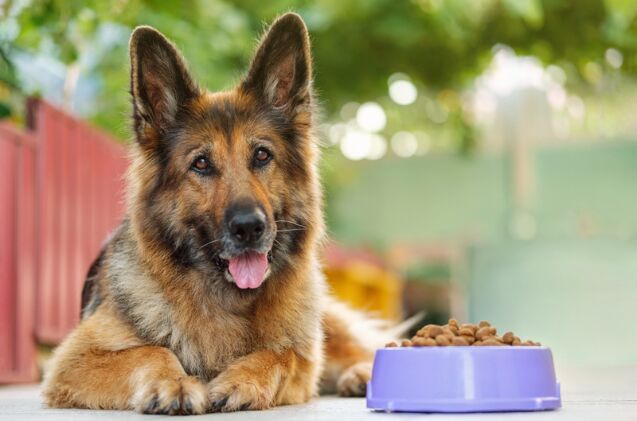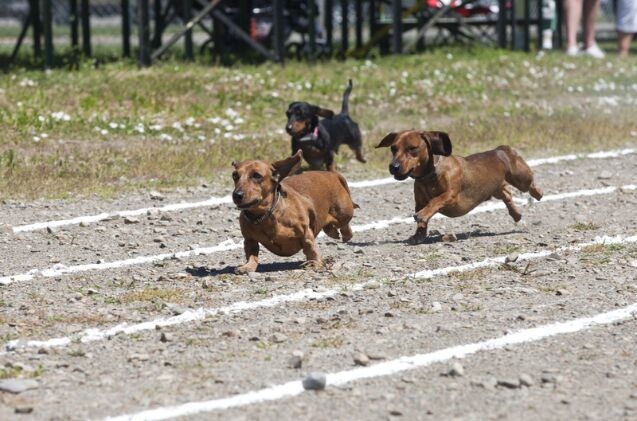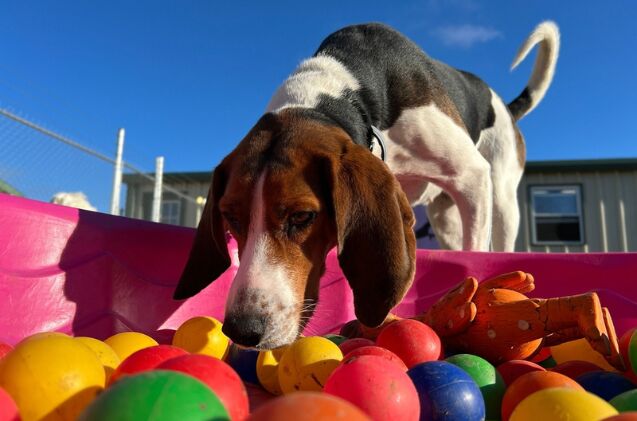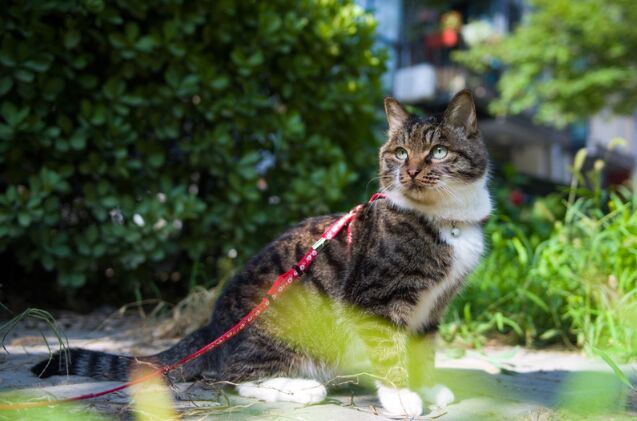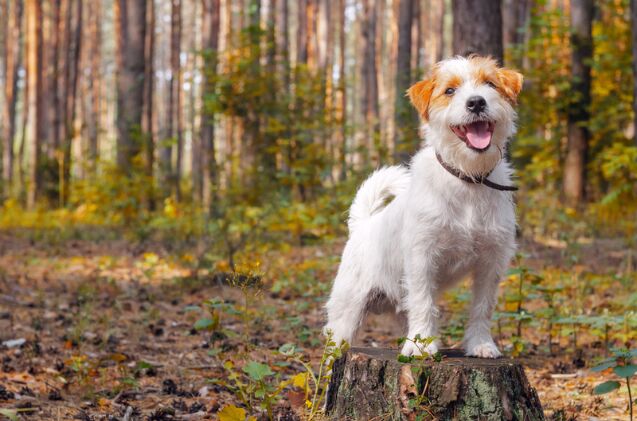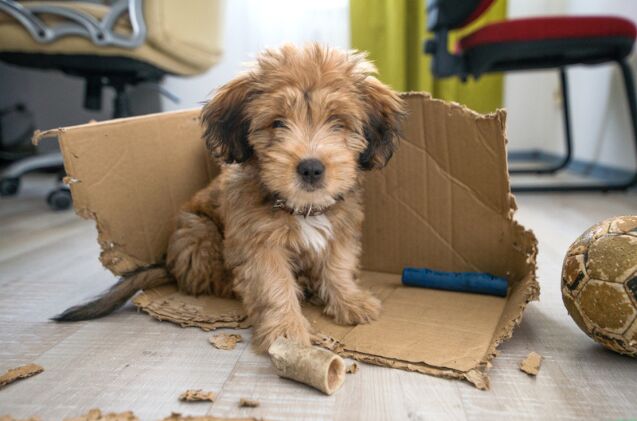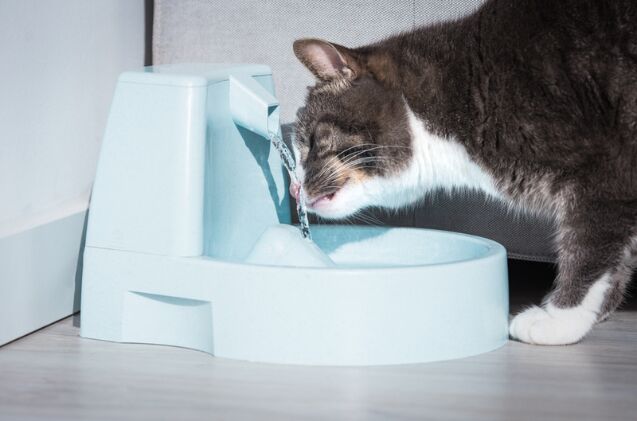Products
How Can You Prevent Bloat in Dogs?
The most valuable tool as pet parents to keep our dogs happy and healthy is knowledge – both knowledge about how to improve their lives but also about the potential risks they may face along the way. One serious condition that every dog parent should be familiar with is Gastric Dilation-Volvulus (GDV), otherwise known as bloat.
This potentially life-threatening condition can strike quickly and unexpectedly, requiring us to be familiar with the early warning signs and when an emergency vet visit is needed.
In this article, we’ll dig into the nitty-gritty of bloat in dogs, including the possible causes, symptoms to watch out for, and steps you can take to prevent bloat in dogs. Let’s get started…
What Is Bloat in Dogs?
GDV, or bloat, is a condition where a dog’s stomach expands after it fills with food, fluid (like water), or gas. As it grows, the stomach either rotates or twists, blocking the entrance and exit, preventing your dog from digesting any food. Additionally, this condition causes blood flow to the stomach and other vital organs to be restricted, which can cause your dog’s health to deteriorate rapidly, making it a life-threatening medical emergency.
What Are the Main Causes of Bloat in Dogs?
While there has been considerable research into gastric dilatation-volvulus and its causes, the exact cause remains unknown. What experts do understand is that there are multiple factors that we can consider when determining if our pup is at risk. By understanding these potential risk factors, we can take steps to reduce the risk and keep our dogs safe.
Some of the leading potential causes and risk factors of bloat in dogs include the following:
- Eating too quickly
- Eating too large of a meal in one sitting
- Genetic predisposition
- Breed
- Age
- Exercise right after eating
However, even if you do your best to avoid all controllable risk factors, that doesn’t guarantee that your dog will never suffer from GDV. Always watch for the warning signs and be prepared to react accordingly.
Beenie Von Weenie Crowned Fastest Wiener Dog in the West
Hold your horses (or your dogs); there’s a new legend racing its way across the finish line. The 26th Annual Wienerschnitzel Wiener Nationals were held July 15th at the Los Alamitos Race Course. This event brings together Dachshunds from all over to race for the title of the “Fastest Wiener Dog in the West.”
When picturing the horizontally gifted Dachshund, most people aren’t picturing race dogs like they do with Greyhounds. But Dachshund racing isn’t a new sport. Records show that it started in the 1970s in Australia. The sport didn’t take off in North America until it was featured in a 1993 Miller Lite commercial.
Today, the United States is the most prevalent location for wiener dog racing (although it still happens in other countries around the world). It is often seen as a publicity event or fundraiser, drawing in record attendance numbers and offering entertainment for dog lovers of all ages.
But what was the Dachshund initially bred for? The breed can trace its roots to Germany, where they were first bred to track and hunt badgers. This explains their unique size and stature. Their short legs allow them to burrow into the dens of their prey, while their long body gives them the ability to move through the underground burrows with ease. The breed’s original creators would never have pictured their little hunting machine tearing down the racetracks.
The race held in California involved smaller groups of Dachshunds racing in short 50-yard trial heats. From approximately 100 competitors, a winner was crowned, and that winner was a 2-year-old chocolate-colored doxie named Beenie Von Weenie!
“Racing from post number two, Beenie Von Weenie flew to a big lead early on, drifted outside to bump Cannonball Charlie and Rowdy, then barked at Penny G in mid-run before focusing on the finish line to win the title by a long ear and tail,” stated race organizers in a press release about the event.
Beenie Von Weenie and his proud owner Nicolee Leonard took home the title of “Fastest Wiener Dog in the West,” along with a new doghouse, $1000, and a trophy to proudly display at home.
Why is Mental Enrichment Important for My Dog?
While physical exercise and a balanced diet are essential elements of a healthy, happy life for your dog, there’s another aspect of their well-being that often goes unnoticed – mental enrichment. Like us, our dogs require mental stimulation to lead fulfilling lives and avoid unnecessary boredom. But you may be asking, why is mental enrichment important for my dog?
In this article, we will look at the different types of enrichment dogs need for a balanced, happy life and how you, as a devoted and loving dog parent, can meet all your dog’s needs.
What is Mental Enrichment for Dogs?
Have you ever been in a situation where you were so bored that your mind was wandering, and you thought you were going crazy? This is because your mind isn’t being challenged. It’s a struggle that your dog can experience too. The difference is that your dog can’t tell you that they are bored and need to do something to exercise their mind. Instead, we need to be proactive and incorporate mental puzzles and challenges into their daily routine to keep them entertained and occupied.
These enrichment activities tap into their instincts and innate behaviors, allowing them to engage in behaviors often discouraged as domesticated pets, like chewing, digging, chasing, scavenging, and hunting. By giving them a safe outlet for these behaviors, we allow them to fulfill their needs while also discouraging them from bad habits like chewing our shoes or digging up the garden.
Why is Mental Stimulation Important for Animals?
Exercising your dog’s mind can help improve their quality of life in several ways. First, it’s critical for preventing boredom. Many behavior issues can be traced back to a bored dog looking for ways to entertain themselves or relieve pent-up energy. Eliminate the boredom, and, in many cases, you can eliminate the problem behavior.
Another great reason to include mental stimulation in your dog’s daily routine is that it helps to keep their mind sharp. As dogs age, many will experience cognitive decline and may develop doggy dementia. The best way to slow the impact of aging on your dog’s mind is to start offering mental exercises regularly at a young age and continue it as your pup gets older.
Finally, experts have discovered that mental enrichment can wear your dog out even faster than physical activity. Have you ever heard the phrase, “A tired dog is a good dog?” By offering mental stimulation, you make it easier for your dog to settle down and relax. This is great for those dealing with issues like reactivity, stress, or separation anxiety.
What is the Best Type of ID for My Dog While Travelling?
Travelling with our dogs is an exciting experience, but it also comes with responsibility – ensuring they are safe at every turn. Whether you’re heading out on a road trip together, camping with your canine companion by your side, jet-setting on a flight, or hiking your local trails, one of the most critical aspects to consider is proper identification.
While traditional ID tags have been a reliable choice and are often seen as the standard ID solution, there are many innovative options for today’s dog parents to choose from.
In this article, we’ll explore the significance of dog identification during travel and delve into many of the options available beyond just traditional hang tags. From microchips and QR codes to GPS tracking devices, discover the many ways to keep your pup safe and accounted for on your next adventure.
Why is Dog ID Important When Travelling?
Before we get into the specifics of different ID options for your pup, let’s start at the beginning. Why is dog ID necessary while travelling, and how can something so simple keep your dog safe?
Every dog parent should be aware of the risk of their pup going missing. In fact, it is estimated that approximately 10 million pets go missing every year in the United States. While it is always a frightening experience when a pet goes missing, imagine it happening somewhere far from home that you and your dog aren’t familiar with. You don’t know where they will go or where to start looking.
It can happen in the blink of an eye despite taking all precautions. Kennel locks fail, leashes break, and dogs can take off quickly when spooked.
Even if your dog is picked up and taken to the local shelter eventually, that is only a piece of the puzzle in bringing them home safely. Without proper identification, the shelter workers have no way of knowing who this dog belongs to, whether they are a stray or someone’s beloved pet, or how to contact you to let you know that they have been found safe.
Ensuring your dog has proper ID at all times can make all the difference in whether they are brought home safely.
Owning a Dog May Protect Your Child From Food Allergies
When it comes to the relationship between children and their pets, many conversations focus on the potential risks of allowing them to interact. But what if having a furry companion could significantly reduce their risk of developing food allergies?
Approximately 1 in 13 American children have food allergies, with 40 percent suffering from allergies to more than one type of food. This number has been on the rise, increasing by approximately 50% between 1997 and 2011. As a result, we have seen changes in our homes, classrooms, public spaces, and every other aspect of our lives. But these food allergies are more than an inconvenience. They can be life-threatening!
We have seen studies exploring the impact of pets on children, their health, and their development before. They have been found to lower blood pressure, improve relationships, and even improve their future career success. It’s also not the first time that researchers have explored the connection between pet ownership and the development of allergies in children. It’s a concept that has been analyzed and discussed for quite a while.
“Some studies show that early exposure to furred animal dander does protect against food allergies. Some show it doesn’t,” stated Dr. Carolyn Kwiat, an allergist and immunologist at Mount Sinai Hospital. The conflicting information baffled scientists and those in the health community. But a recent study published in March 2023 has shed light on the connection between owning a dog and its potential impact on childhood allergies, and the results are promising.
The study, conducted in Japan, found that exposure to a dog or cat while a child is in utero or during the first few months of their life lowered the risk of developing a food allergy by approximately 14%. It included a sample size of 66,000, making it the largest of its kind.
However, a few aspects of the study may lead some to question the accuracy of its findings. The biggest concern was that the diagnosis of food allergies in the children being observed was not confirmed with medical testing. Instead, it was based on a questionnaire completed by the participating parents.
Still, the study introduces new information, encouraging researchers and healthcare professionals to explore the potential connection further. The large sample size allowed researchers to explore not only the fundamental question of whether a connection existed but also to better understand the impact of different pet species, the timing of the child’s exposure, and how it applied to allergies associated with a variety of foods.
Can I Let My Cat Go Outdoors Safely?
As cat lovers and parents, we understand our kitties' curiosity and desire for the great outdoors. We’ll often find our two cats sitting by the window, entirely in a trance, as they watch the birds or just the leaves moving in the breeze. But the thought of letting them roam freely outside stirs up many worries about their safety – we don’t endorse the outdoor cat lifestyle.
Does this mean our cats are stuck indoors without ever having the chance to feel the grass under their paws? Not necessarily!
This article will delve into the exciting world of outdoor adventures for your cat while prioritizing their safety. Whether it's learning the art of leash and harness training, creating a cat paradise in the form of a catio, or exploring other safe containment options, you can rest assured that your indoor cat will enjoy the wonders of nature without compromising their well-being.
Do Indoor Cats Want to Be Outside?
It’s a question that we often hear as cat parents, especially having such an outdoor-focused lifestyle ourselves. Do our indoor cats want to be outside? Does keeping them indoors somehow take away from their quality of life? Would it be better to give them the freedom to explore the outdoors around us?
The truth is that you can give a cat an incredible and fulfilled life indoors. In fact, most experts recommend an indoor life for cats to keep them safe and extend their lifespan.
Of course, there are pros and cons to both indoor and outdoor lifestyles. Many indoor cats suffer from obesity and other unhealthy lifestyle challenges due to a lack of physical activity. They may also feel bored due to a lack of enrichment in their daily lives. Luckily, these are challenges that you can overcome.
If you have an indoor cat, there are a few key elements of their lives that you need to consider, including:
- Feeding a healthy, balanced diet
- Encouraging daily physical activity
- Supporting their instinctual urges (scratching, hunting, etc.)
- Providing mental enrichment
This isn’t to say that your indoor cat is never interested in exploring outside, especially if they spend much of their time watching wildlife through the window. Many indoor cats are curious about the sights and smells.
Which Dog Breeds Make Us Happiest, According to Social Media?
As dog parents, we love sharing pictures and stories of our pups. After all, we all have the cutest, most adorable dog. Right? Sometimes these stories are funny, share special heartfelt moments, and sometimes these posts are sad stories that tug at our hearts. Curious about this range of emotions, Protect My Paws recently analyzed the content in nearly a quarter of a million dog-themed tweets. From here, they identified the 10 dog breeds that make us the happiest – and the results were surprising!
To analyze and understand the emotions connected to each tweet in the study, they used the NRC Lexicon. This tool looks at the entire sentence, scanning it for recognizable emotional words and phrases. This included happy, sad, fearful, and trustful phrases.
The result was a breakdown of which dog breeds associated with each emotion, and the results were surprising. While you may have expected to see German Shepherd Dogs among the most trustworthy or Golden Retrievers topping the dogs that make us feel the happiest, you may be shocked. The breeds that made this list stray from the usual stereotypes.
So, what dogs make us the happiest?
The study found that the little black furball known as the Affenpinscher was happily talked about the most on social media! This breed may only weigh between 7 and 13 lbs. fully grown, but they are full of personality. They are described as being feisty, inquisitive, stubborn, and humorous. Of the 200k tweets analyzed, 240 “joyful” words were identified per 1000 related to the Affenpinscher.
Other dog breeds on this happiest list included:
- Staffordshire Bull Terrier (207)
- Vizsla (194)
- West Highland White Terrier (192)
- Portuguese Water Dog (185)
- Bullmastiff (183)
- Chesapeake Bay Retriever (184)
- Samoyed (176)
- American Staffordshire Terrier (175)
- English Cocker Spaniel (174)
Can I Travel With An Anxious Dog?
Traveling with your pet can be an exciting experience, but it can also come with a unique set of challenges for those with anxious dogs. Whether you’re planning a big summer road trip, flying to a distant location, or simply visiting friends and family, understanding and addressing your anxious dog’s needs during travel is critical to ensuring a safe and comfortable experience for both of you.
In this post, we will discuss how to navigate the world of travel with your anxious pup, including how to prepare for your next trip and help them feel secure and calm during the journey.
Is Traveling Stressful for A Dog?
There is no easy answer to this question. Why? Like people, some dogs will be happy and comfortable traveling. However, others may find the whole experience frightening. This could result from a bad experience in the past or simply a lack of travel experience. The good news is that (in most cases) you can take steps to help your dog feel more comfortable during your adventures.
2 in 3 Dog Owners Claim Their Dogs 'Could Never Survive in the Wild'
If your pet were to get loose outdoors, would they know how to survive on their own? If not, you're not alone! A recent poll conducted by One Poll and commissioned by Now Fresh revealed that 2 in 3 dog owners believe their dog would never be able to survive solo in the wilderness.
The study was conducted between March 20 and March 23, 2023, asking down owners a series of questions related to their dog's dependence (or lack thereof), their lifestyle, and their current diet.
At a time when many companies are focusing their brand messaging on the connection between dogs and wolves, it revealed an interesting conclusion: Dog owners recognize that while wolves may be their ancestors, today's domestic dogs live a very different way of life. Of those surveyed, 86% of owners reported that their dog lives "a life of luxury," while 77% agreed that dogs today have grown accustomed to being cared for and catered to.
But what does this information have to do with a dog's dietary needs?
"Dogs have evolved from their wolf ancestors in so many ways," said Theresa Lantz, companion animal nutritionist at Petcurean, makers of NOW FRESH Pet Food. "This evolution also includes changes to their nutritional needs. When we consider how different their lifestyles today are - which include being more sedentary and dependent on humans - we must also take into account that those nutritional requirements would change too."
Can I Travel With My Cat in the Car Safely?
If you’re planning a trip with your feline best friend, you may be experiencing both excitement and a little concern. Unlike dogs, known for their love of the car, many cats aren’t keen on a road trip. But you’ll be happy to know that you CAN help your cat learn not only to tolerate but enjoy car travel.
Let’s look at how you can travel with a cat in the car safely, including both short trips and longer road trip adventures…
How Do I Introduce My Cat to the Car?
If this is your cat’s first time in the car, you should plan to start small. Try taking your cat out into the car in your driveway and allowing them to get used to it before even putting it in motion. This is a great way to reduce anxiety and set yourself up for long-term success.
When you see that your cat is comfortable with being inside your vehicle, try introducing the next step by starting the engine. This will introduce a new sound and feeling, which can be frightening. Talk to your cat calmly and comfort them.
Continue this slow introduction by moving the vehicle slightly up and down the driveway, then going for a short drive around the block. With each step, ensure your cat is comfortable and relaxed before moving on to the next.
As tempting as it may be, don’t rush this process. Offer a lot of praise and treats to create a positive association with the vehicle and the experience as a whole.
How Long Can Cats Ride in a Car?
The time or distance your cat can successfully ride in a vehicle will depend on several factors. This includes their comfort level in the vehicle, the “amenities” you make available to them (like food, water, and a litter box), and the number of stops you make along the way.
For some cats, a 6-hour car ride is completely relaxing, and they will sleep the whole time. For others, however, even 10 minutes can feel like an eternity.
How Do I Stop My Dog From Eating Everything?
We often hear about the importance of getting out and walking our dogs. But what do you do if your dog is determined to eat everything in sight every time you are out and about? Not only is this behavior frustrating, but it can also be very dangerous. There is the risk that your dog will eat a toxic substance or swallow something that causes a life-threatening gastrointestinal blockage.
If this concerns you, you’re not alone! It’s a struggle faced by many dog parents. In this article, I will share 8 solutions to stop your dog from eating everything. Proper management is the key to keeping your pup safe.
Why Does My Dog Eat Literally Everything?
For most dogs, the desire to scavenge and eat everything they can find is nothing more than an instinct. In the wild, your dog’s ancestors had to find enough food daily to meet their nutritional needs. This often meant eating things that may have been less than desirable to get through from one solid meal to the next.
While your pup has the guarantee of a full food dish waiting for them, they may still pick up anything they believe is edible without giving it a second thought.
There is a chance that your dog is trying to tell you that there is something bigger going on. A dog that is missing something in their diet may eat items they find to meet this need. This could also indicate that they are still hungry for medical reasons. If they are suffering from a condition preventing them from feeling satisfied or absorbing the nutrients they need, this could lead to scavenging for food.
Finally, there is a small chance that your dog is suffering from a condition known as Pica. This disorder is when a dog compulsively eats or chews on non-food items. This may present as an obsession with eating rocks, dirt, plastic, cloth, or cardboard. This behavior must be addressed for your dog’s health and safety.
These unusual eating habits could also result from boredom, anxiety, or a need for mental enrichment.
How Do I Create a DIY Busy Box for My Dog?
5 Types of Dog Enrichment
When people talk about enrichment for dogs, they often focus on two forms – physical enrichment and mental enrichment. But you may be surprised to learn that there are five types to consider, each with unique benefits for your dog. To provide the best possible quality of life for your dog, you will need to consider how to find (or create) opportunities for all five types of enrichment.
Physical
Just as we must be physically active for our health and well-being, so do our dogs. The amount of exercise your dog needs will vary from dog to dog, depending on their age, breed, and lifestyle. For example, a high-energy puppy will need more daily activity to feel satisfied than a senior dog, and a high-energy working breed will need more exercise than a calm, companion breed. Physical enrichment includes everything from walking around the block or playing fetch in the backyard to navigating a challenging hiking trail. The goal is to get up and moving.
Nutritional
Activities that fall under the nutritional enrichment category require your dog to hunt or forage for their food. This includes food puzzles, treat dispensing toys and snuffle mats. But you don’t have to purchase a fancy product to incorporate nutritional enrichment. One easy (and free) solution is to hide treats around the room and watch your dog sniff out the rewards. Games like this tap into your dog’s natural instincts.
Social
With the recent boost of dogs being adopted during the lockdown, this is a need that many new dog parents didn’t meet. Not because they didn’t want to, they simply didn’t know better. But socialization is essential to raise a well-behaved and well-adjusted dog. The key to socializing your dog correctly is to do it slowly and under careful supervision.
Allow your dog to discover new people, places, and things without feeling frightened or in danger. If you are letting your dog meet a dog for the first time, it should be done carefully with both dogs under control to prevent fights or other unpleasant situations. This is why so many dog trainers discourage dog parks and off-leash areas. Many well-meaning dog parents will bring their pups to these locations only to have them rushed by an “overly friendly” dog, causing overstimulation which can lead to fear or aggression. Instead, consider signing up for a puppy training class or arranging supervised puppy play dates with a dog lover you know and trust.
In addition to introducing your dog to other dogs, social enrichment should include interactions with people, cats, objects (like cars and bicycles), and new environments. Make sure you are in control heading into each experience, and remove your dog quickly if you see they are becoming overwhelmed.
Lab/Shepherd Mix Zoey Claims Title of World’s Longest Dog Tongue
We all believe our dog is special and unique, but for some dog parents, this statement means something more. A small number of dog parents around the world can lay claim to being recognized by Guinness World Records. Three-year-old Labrador/German Shepherd mix Zoey and her family, the Williams family, are now part of that elite group as Zoey claims the record for the World’s Longest Tongue on a Living Dog.
A dog’s tongue plays a vital role in many aspects of their daily lives. They use them to pick up and eat food, lap water, and even cool themselves down when temperatures soar. When your pup is trying to investigate an interesting scent, the tongue helps to better smell their surroundings. Of course, there are also those sloppy kisses!
The Williams family noticed the length of Zoey’s tongue as a young puppy but assumed it was just a feature she was growing into. After all, many puppies have features that seem out of proportion as they grow up, like large bat ears and gigantic paws.
However, as Zoey grew up, the family realized that her tongue continued to grow with her. Her tongue can be seen hanging out proudly in all of her pictures. “We got Zoey when she was only six weeks old,” explained Sadie Williams. “And in the first-ever picture we have of her, she has her tongue sticking out.”
An English Setter previously held the record named Bisbee in Tucson, Arizona, whose tongue was officially measured at 3.74 inches. Before Bisbee, the title was held by a St. Bernard named Mochi for over five years until 2021, when she passed. Her tongue measured in at a shocking 7.3 inches.
After having several friends and family members suggest that Zoey’s tongue could challenge this record, Drew ad Sadie Williams decided to go through the process. They had to take Zoey to a veterinarian for an official measurement to be taken. This appointment was recorded and submitted to Guinness with a package of videos, photos, and witness statements to confirm that the claim was valid and that the measurement was taken fairly and accurately.
When all was said and done, Zoey’s tongue officially measured at 5 inches, claiming the record. Guinness compared her tongue to the size of a standard soda can, which measures 4.8 inches.
Scooter, a Chinese Crested, Awarded the Title of World’s Ugliest Dog
As dog lovers, we’re all familiar with the Westminster Dog Show and the perfectly groomed and well-trained dogs that it introduces to the world. But in Petaluma, California, a different group of pups is being shown the spotlight… This city in the San Francisco Bay Area is home to the World’s Ugliest Dog Contest.
Hosted as part of the Sonoma-Marin Fair, this show celebrates the unique qualities that make every dog special, even if they don’t fit the traditional definition of “beauty.” For nearly 50 years, this one-of-a-kind contest has brought together dogs of all sizes, backgrounds, breeds, and ways of life. While they may have little quirks that make them an individual, like crossed eyes, underbites, mismatched ears, or abnormal stances, these pups quickly capture the hearts of everyone they meet.
This year, the contest was held on June 23rd. The judging panel featured some big names, including Miss California Catherine Liang and Gaudi Schwartz, co-host of NBC news Stay Tuned. After viewing all the contestants, including paperwork confirming they are healthy (despite their unique features), the title was awarded to a Chinese Crested named Scooter.
Are Water Fountains Good for Cats?
As a cat parent, you understand that our feline friends deserve nothing but the best. This means prioritizing their well-being and identifying potential health risks you can prevent. One such risk you should be familiar with is dehydration. Ensuring your cats drink enough water to meet their daily needs can be challenging. If you’re currently struggling with this, I am here to help.
Check out this article for tips and tricks to encourage your cat to drink more water. Plus, I’ll share why we love water fountains for all pets in our home.
Do Cats Get Dehydrated Easily?
While any pet may struggle with dehydration, it’s surprisingly common among cats. Why? Unlike dogs and other pets, most cats don’t have the desire to drink plain water. Experts say that this can be traced back to their roots.
In the wild, cats are obligate carnivores – meaning they depend strictly on meat for survival. Meat contains high moisture levels, allowing them to obtain most of the water they need through their food. However, the same can’t be said with the shift to commercial cat foods and treats, especially dry kibble. This makes it more important than ever for cat parents to be proactive with hydration.



